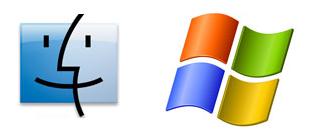Neither OS is perfect. Each could learn from the other.

AUTHOR’s NOTE: The ABA is (thankfully) moving to a content management system (i.e. a database) for its website, which means that, for now, ABA archives are even harder to find than they were previously. So I’m not sure if this sidebar actually was previously published by the ABA or not. I’ve been writing for the ABA since 1994, and I often look for stuff I’ve written previously in my own articles database (Erik has a content management system and the ABA doesn’t? – shocking), but sometimes I don’t remember if the piece I’m looking for was an article or a sidebar. In any event, I digress. The following may or may not have been first published 5/1/2003 in Law Practice Management magazine, “nothing.but.net” column; American Bar Association.
Now that I’ve got a new MacBook and have been running OS X 1.4 and Windows XP in the same computer (thanks to Parallels), I was reminded of this piece (from 05/01/03) about the good and the bad inherent in each operating system.
| Sidebar – Top 10 Annoying Things About Macintosh Computers | Sidebar – Top 10 Annoying Things About Windows Computers |
| Mice. The one-button mouse provides limited functionality. | Mice. The two-button mouse is confusing and hard to use for left-handed people (or right-handed people like me who use the mouse with their left hand). |
| Disks. The 3.5″ floppy disks cannot be read in a PC without additional software. When Apple finally fixed this flaw, they called the new drive a “SuperDrive,” which, annoyingly, requires additional software in order to read/write PC floppy disks. | Disks. PCs are not smart enough to know when floppy disks are inserted or removed. The “abort, retry, fail” error still occurs today and is a classic example of horrible user interface. |
| Monitors. Computers frequently come with integrated monitors, which leaves users with no display options. | Monitors. Computers typically do not include monitors, and there are too many monitors to choose from. |
| Keyboard Commands. The keyboard has oddly named keys such as “escape” and “control” and baffling commands such as command-control-power to reboot and command-option (on startup) to rebuild the desktop database. | Keyboard Commands. The keyboard has oddly named keys such as “escape” and “control” and baffling commands such as control-alt-delete to reboot and F8 (on startup) to boot in “safe mode.” |
| Text Files. In UNIX, text file line-endings are terminated with a newline (\n), which is also called a linefeed (LF), but in Macintosh (pre-OS X, which uses the Unix standard), line-endings are terminated with a single carriage return (CR)(\r). | Text Files. In UNIX, text file line-endings are terminated with a newline (\n), which is also called a linefeed (LF), but Windows, line-endings are terminated with a combination of a carriage return (\r) and a newline(\n), also referred to as CR/LF. |
| Files. Some versions of MacOS allow only 32-character file names. Some non-alphanumeric characters are allowed in filenames, which can cause problems on UNIX systems. Plus files are stored in two parts or “forks,” a data fork and a resource fork, so if you copy a binary file from a Macintosh computer to a non-Macintosh computer, you may end up losing half of the file (which could render the file useless). | Files. Some versions of Windows allow only 32-character file names, and older versions allowed only 8-character filenames (plus three-letter extensions). Some non-alphanumeric characters are allowed in filenames, which can cause problems on UNIX systems. Plus many files are stored as “hidden” files by default. |
| File/Application Mappings. Files include a four-letter “creator” code that dictates which program will open the file when you double-click on it. It’s nontrivial to change the mapping for a particular file, especially within e-mail and web applications. | File/Application Mappings. Files include a three-letter “extension” that dictates which program will open the file when you double-click on it. It’s nontrivial to change the mapping for a particular file, especially within e-mail and web applications. |
| Networking. Rather than use existing Unix networking protocols, Apple decided to create its own protocols such as AppleTalk. | Networking. Rather than use existing Unix networking protocols, Microsoft decided to create its own protocols such as Windows Networking. |
| User Interface. Apple arguably stole the user interface for the Macintosh from Xerox PARC and got away with it. | User Interface. Microsoft arguably stole the user interface for Windows from Apple and got away with it. |
| Operating System. The MacOS operating system is inherently proprietary. Even though Mac OS X is based on FreeBSD, there is no indication that the operating system will ever be licensed to third party developers or converted to open source. | Operating System. The Windows operating system is inherently proprietary, and Microsoft itself has admitted that Windows95 is “inherently insecure.” There is no indication that Windows will ever be licensed to third party developers or converted to open source. |


